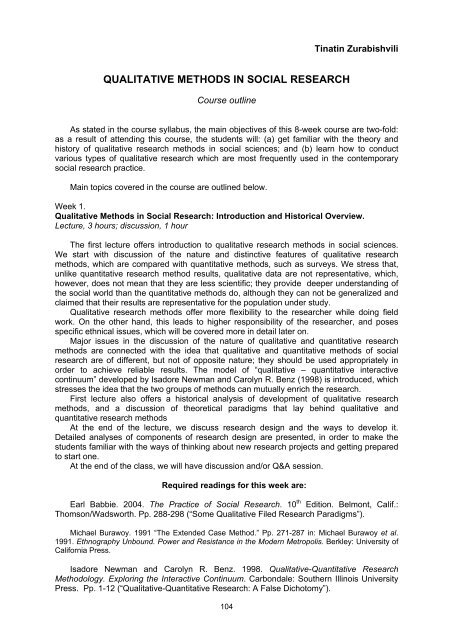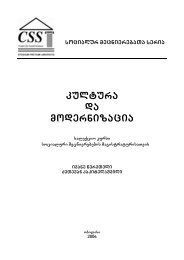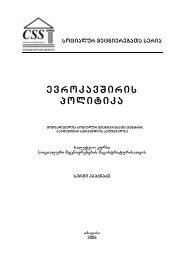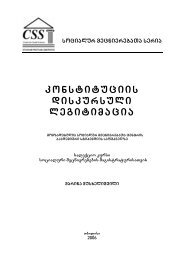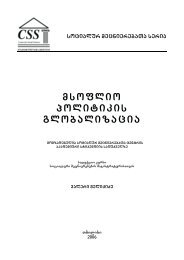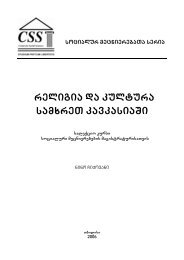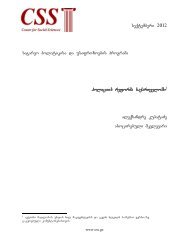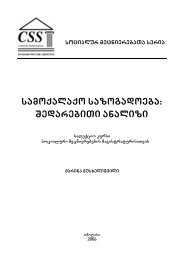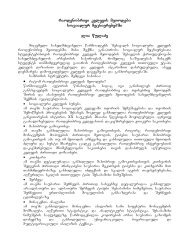Tvisebrivi meTodebi socialur kvlevaSi - Center for Social Sciences
Tvisebrivi meTodebi socialur kvlevaSi - Center for Social Sciences
Tvisebrivi meTodebi socialur kvlevaSi - Center for Social Sciences
You also want an ePaper? Increase the reach of your titles
YUMPU automatically turns print PDFs into web optimized ePapers that Google loves.
Tinatin Zurabishvili<br />
QUALITATIVE METHODS IN SOCIAL RESEARCH<br />
Course outline<br />
As stated in the course syllabus, the main objectives of this 8-week course are two-fold:<br />
as a result of attending this course, the students will: (a) get familiar with the theory and<br />
history of qualitative research methods in social sciences; and (b) learn how to conduct<br />
various types of qualitative research which are most frequently used in the contemporary<br />
social research practice.<br />
Main topics covered in the course are outlined below.<br />
Week 1.<br />
Qualitative Methods in <strong>Social</strong> Research: Introduction and Historical Overview.<br />
Lecture, 3 hours; discussion, 1 hour<br />
The first lecture offers introduction to qualitative research methods in social sciences.<br />
We start with discussion of the nature and distinctive features of qualitative research<br />
methods, which are compared with quantitative methods, such as surveys. We stress that,<br />
unlike quantitative research method results, qualitative data are not representative, which,<br />
however, does not mean that they are less scientific; they provide deeper understanding of<br />
the social world than the quantitative methods do, although they can not be generalized and<br />
claimed that their results are representative <strong>for</strong> the population under study.<br />
Qualitative research methods offer more flexibility to the researcher while doing field<br />
work. On the other hand, this leads to higher responsibility of the researcher, and poses<br />
specific ethnical issues, which will be covered more in detail later on.<br />
Major issues in the discussion of the nature of qualitative and quantitative research<br />
methods are connected with the idea that qualitative and quantitative methods of social<br />
research are of different, but not of opposite nature; they should be used appropriately in<br />
order to achieve reliable results. The model of “qualitative – quantitative interactive<br />
continuum” developed by Isadore Newman and Carolyn R. Benz (1998) is introduced, which<br />
stresses the idea that the two groups of methods can mutually enrich the research.<br />
First lecture also offers a historical analysis of development of qualitative research<br />
methods, and a discussion of theoretical paradigms that lay behind qualitative and<br />
quantitative research methods<br />
At the end of the lecture, we discuss research design and the ways to develop it.<br />
Detailed analyses of components of research design are presented, in order to make the<br />
students familiar with the ways of thinking about new research projects and getting prepared<br />
to start one.<br />
At the end of the class, we will have discussion and/or Q&A session.<br />
Required readings <strong>for</strong> this week are:<br />
Earl Babbie. 2004. The Practice of <strong>Social</strong> Research. 10 th Edition. Belmont, Calif.:<br />
Thomson/Wadsworth. Pp. 288-298 (“Some Qualitative Filed Research Paradigms”).<br />
Michael Burawoy. 1991 “The Extended Case Method.” Pp. 271-287 in: Michael Burawoy et al.<br />
1991. Ethnography Unbound. Power and Resistance in the Modern Metropolis. Berkley: University of<br />
Cali<strong>for</strong>nia Press.<br />
Isadore Newman and Carolyn R. Benz. 1998. Qualitative-Quantitative Research<br />
Methodology. Exploring the Interactive Continuum. Carbondale: Southern Illinois University<br />
Press. Pp. 1-12 (“Qualitative-Quantitative Research: A False Dichotomy”).<br />
104


